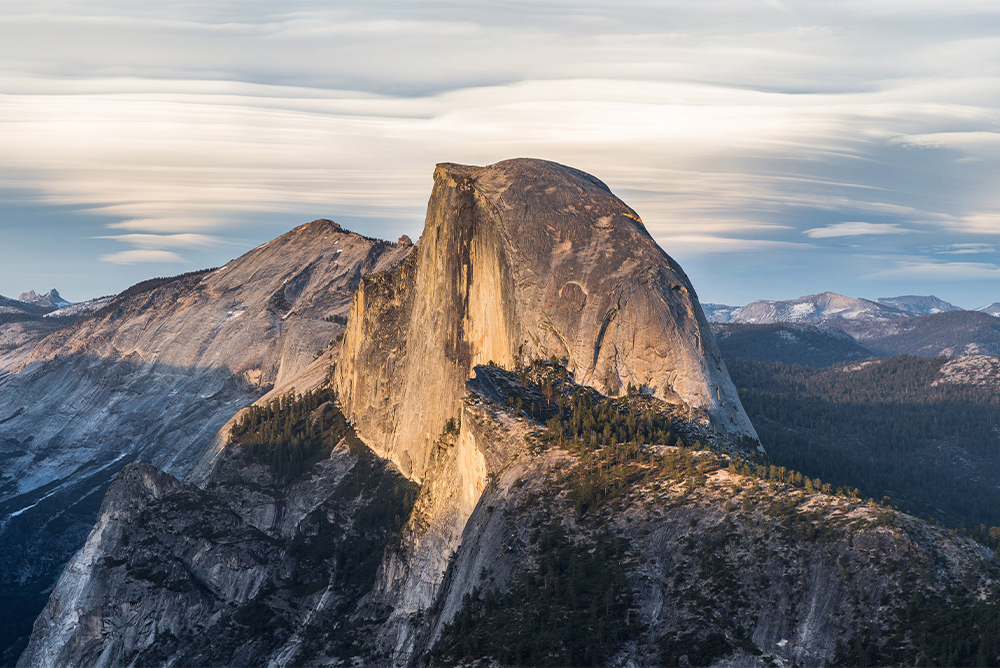
The Wilderness Act protects 175,000 square miles of public land. As the natural world is transformed by climate change, has the landmark 1964 law become counterproductive? Biologists Daniel T. Blumstein and Thomas B. Smith explain. Half Dome in Yosemite National Park. Courtesy of Wikimedia Commons.
At the end of 2023, four environmental groups sued the National Park Service and invoked the Wilderness Act to stop the replanting of trees following a catastrophic wildfire in Sequoia and Kings Canyon National Parks. Around the same time, the National Park Service announced that it aimed to invoke the Wilderness Act to limit the use of fixed anchors on Yosemite’s iconic big wall climbs.
How did a law created 60 years ago to protect nature in undeveloped areas come to do something else entirely—and, in the process, become counterproductive to its own goals? Today, the Wilderness Act of 1964 preserves nearly 175,000 square miles of public land in the United States, largely roadless expanses only accessible on foot or pack animal. We need to preserve such wild spaces more than ever: They are where threatened species and their habitats can best flourish with minimal human impacts.
But the California national parks where environmental stewards are applying to the Wilderness Act are neither remote nor roadless. Instead, the appeals to the Wilderness Act in those parks are part of a shift in approach to the law that may, in the end, run counter to its aims—and that needs to be rethought.
In addition to these cases, the Wilderness Act has increasingly been used to limit scientific research in protected areas. This includes research on habitats being ravaged by the effects of climate change and disease outbreaks that directly affect the biodiversity that the act seeks to protect. Many of the limited activities are essential to understanding the ecological and evolutionary processes needed to manage these lands in the future, but they are not permitted—or are permitted only in highly exceptional cases—under the Wilderness Act.
As conservation biologists, we work in remote natural laboratories around the globe. Dan Blumstein spends his summers studying marmots at the Rocky Mountain Biological Laboratory (RMBL) near Crested Butte, Colorado. Crested Butte is a renowned recreation and nature tourism destination; RMBL is an internationally recognized research station that abuts the 283-square-mile Maroon Bells-Snowmass Wilderness Area.
Over the past decade, the RMBL has started to host hydrological and atmospheric studies with staggering possibilities thanks to new, remote-sensing technology that can collect constant data. Small weather stations and sensors create increasingly precise models of the ground growth conditions and help us understand precipitation and snowmelt. Conducting these studies near Crested Butte, at the headwaters of the Colorado River, is essential to understanding the hydrological dynamics that ultimately provide water for 40 million people in the southwestern United States and northeastern Mexico.
However, Wilderness Act protections mean that scientists cannot establish weather stations, deploy semi-permanent sensors, establish remotely triggered cameras to monitor wildlife, permanently mark individual plants with small metal tags, or leave small, plastic rain gauges out on these lands. There is a process to request exceptions, but it is arduous—and the government almost always denies them.
Should there be research in Wilderness Areas, and if so, what degree of research-related impacts are acceptable? Should we, as a society, permit recreational use, but not science in these minimally impacted areas? The government must reevaluate how the Wilderness Act is deployed. We assert this not because we view natural areas as unimportant, but rather because we view them as essential resources that can help us manage biodiversity.
Human-driven change—an unplanned global experiment on the Earth—is happening everywhere in this Anthropocene era. We are living through a global experiment with the planet’s biodiversity. We urgently need wilderness areas with limited human impacts as safe harbors for the biodiversity we depend on. At the same time, it’s futile to pretend that those areas experience no human impacts at all.
Scientific research helps find solutions for restoring habitat and protecting biodiversity while managing the impacts of humans. This includes research on how human activities alter the traits and resilience of existing species. For instance, Thomas Smith researches how climate change will affect biodiversity in Central Africa as species have to move to new habitats or adapt to avoid extinction. He and others used genomics to identify where a given species would be best adapted to future, warmer climates. Then, they worked with conservation officials to select areas for new parks that would best protect species.
In the Anthropocene, we need the Wilderness Act more than ever before, in part because humans’ myriad assaults on the environment have increased the value of minimally impacted land. Yosemite, Sequoia, and Kings Canyon National Parks welcome millions of annual visitors, and they serve an important—but entirely different—purpose than the areas the act protects, which are both repositories of nature and necessary places to study ecological processes.
When people—often with good intentions—invoke the act in ways that hamstring both effective federal management of public lands and scientific research, we’re left with the Wilderness Act being used as a bludgeon against effective natural resource management and a barrier to obtaining necessary scientific knowledge. As we face climate change’s unprecedented changes on our natural surroundings, we also have to rethink how we interpret the laws that protect those surroundings in novel and unexpected ways.
Aldo Leopold, the father of conservation biology, once said, “One of the penalties of an ecological education is that one lives alone in a world of wounds.” Leveraging the very best science and ecological knowledge gained from wild areas to become better stewards of our small planet is one way to help redress those wounds.




Send A Letter To the Editors